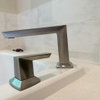Gate valve or ball valve for water lines
skeeter_ca
11 years ago
Related Stories

LIFEThe Top 5 Ways to Save Water at Home
Get on the fast track to preserving a valuable resource and saving money too with these smart, effective strategies
Full Story
GREEN BUILDINGWater Sense for Big Savings
Keep dollars in your pocket and preserve a precious resource with these easy DIY strategies
Full Story
SAVING WATER11 Ways to Save Water at Home
Whether you live in a drought-stricken area or just want to help preserve a precious resource, here are things you can do to use less water
Full Story
DISASTER PREP & RECOVERYRemodeling After Water Damage: Tips From a Homeowner Who Did It
Learn the crucial steps and coping mechanisms that can help when flooding strikes your home
Full Story
SAVING WATERXeriscape Gardens: How to Get a Beautiful Landscape With Less Water
Conserve water and make gardening much easier with the xeriscape approach’s 7 principles
Full Story
GREAT HOME PROJECTSHow to Switch to a Tankless Water Heater
New project for a new year: Swap your conventional heater for an energy-saving model — and don’t be fooled by misinformation
Full Story
GREEN DECORATINGEasy Green: Big and Small Ways to Be More Water-Wise at Home
These 20 tips can help us all make the best use of a precious resource. How do you save water in summer?
Full Story
GARDENING GUIDESEssential Watering Tips for Your Edible Garden
To give your edible plants just what they need, check out these guidelines for how, when and how much to water
Full Story
GREAT HOME PROJECTSHow to Add a Solar Water Heater
Lower energy bills without a major renovation by putting the sun to work heating your home’s water
Full Story
LANDSCAPE DESIGNSee a Lush Australian Garden That Needs Little Water
Highly self-sufficient and sustainable, this oasis near Sydney offers something special around every corner
Full StoryMore Discussions








randy427
skeeter_caOriginal Author
Related Professionals
Boise Plumbers · Worcester Plumbers · Adelphi Kitchen & Bathroom Remodelers · Beach Park Kitchen & Bathroom Remodelers · East Tulare County Kitchen & Bathroom Remodelers · Holden Kitchen & Bathroom Remodelers · Calverton Kitchen & Bathroom Remodelers · Chester Kitchen & Bathroom Remodelers · Islip Kitchen & Bathroom Remodelers · Morgan Hill Kitchen & Bathroom Remodelers · Payson Kitchen & Bathroom Remodelers · Port Charlotte Kitchen & Bathroom Remodelers · Spanish Springs Kitchen & Bathroom Remodelers · Prairie Village Kitchen & Bathroom Remodelers · Mountain Top Kitchen & Bathroom Remodelersrandy427
lazypup
jscozz
User
User
dwpc
SparklingWater
brickeyee
SparklingWater
brickeyee
jackfre